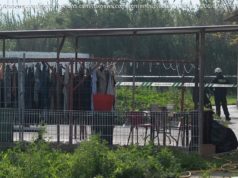Research shows places with BLM protests from 2014 to 2019 saw a reduction in police homicides but an uptick in murders.
There’s long been a fierce debate about the effect of Black Lives Matter protests on the lethal use of force by police. A new study, one of the first to make a rigorous academic attempt to answer that question, found that the protests have had a notable impact on police killings. For every 4,000 people who participated in a Black Lives Matter protest between 2014 and 2019, police killed one less person. Travis Campbell, a PhD student in economics at the University of Massachusetts Amherst, released his preliminary findings on the Social Science Research network as a preprint, meaning the study has yet to receive a formal peer review. While Campbell’s research does not encompass the events of summer 2020, George Floyd’s killing and the subsequent wave of protests became potentially the largest movement in American history, the sudden growth of which relied on a wave of anger and grief at the police homicides Americans are continually greeted with on the news. Opinion columnists, activists, lawmakers, and even the president of the United States ( current and former) have weighed in on these protests and what the appropriate policy changes should be. But first, it’s important to grapple with how the protests have already changed policing. From 2014 to 2019, Campbell tracked more than 1,600 BLM protests across the country, largely in bigger cities, with nearly 350,000 protesters. His main finding is a 15 to 20 percent reduction in lethal use of force by police officers — roughly 300 fewer police homicides — in census places that saw BLM protests. Campbell’s research also indicates that these protests correlate with a 10 percent increase in murders in the areas that saw BLM protests. That means from 2014 to 2019, there were somewhere between 1,000 and 6,000 more homicides than would have been expected if places with protests were on the same trend as places that did not have protests. Campbell’s research does not include the effects of last summer’s historic wave of protests because researchers do not yet have all the relevant data. It’s worth noting that Campbell didn’t subject the homicide findings to the same battery of statistical tests as he did the police killings since they were not the main focus of his research. (He intends to do more research on how these protests affected crime rates.) But his research on homicides aligns with other evidence. Omar Wasow, a professor at Princeton University who has done seminal research on the effect of protests, told Vox that the results are “entirely plausible” and “not surprising,” considering existing protest research. The reasons for this rise in murders are not fully known, but one possible explanation is that police morale drops following scrutiny, leading officers to reduce their efforts and thereby emboldening criminals. Another is that members of the public voluntarily withdraw from engagements with the police after a police homicide delegitimizes the justice system in their eyes. (More on this below.) Protests can do a lot. They can raise awareness, create solidarity or undermine existing relationships, change public opinion, strengthen or weaken institutions, and affect the outcome of elections. But, according to this study, BLM protests also produce their intended effect. A few notes on methodology It’s important to understand how Campbell conducted his research and the potential pitfalls when trying to quantify and isolate how protests can affect policy. Researchers who study crime, police lethal force, and protests are hampered by something out of their control: The underlying data can be faulty. For lethal force data, there’s no federal database to turn to. Instead, Campbell and other researchers have to rely on nonprofit- and media-collected data, which has some drawbacks. This means Campbell may be missing some police homicides in his research. Harvard University sociologist Joscha Legewie told Scientific American that the study’s design is “‘very well suited’ for the kind of data Campbell” is looking at. Additionally, there could be something systematically different about the places that have BLM protests that make them more poised for increased police accountability than places without. For instance, a new mayor or district attorney who championed police reform gets elected and then protest movements mobilize to ensure their desired reforms are implemented. To account for this problem, Campbell controls for various factors — from the localities’ unemployment rate to the Democratic vote share in the 2008 presidential election — to try to make sure he is isolating the effect of BLM protests on police homicides and other murders.






